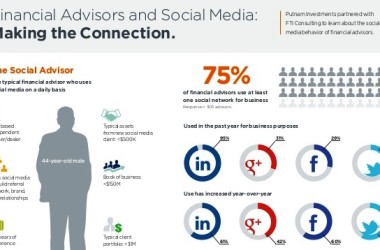
(InvestmentNews.com)-Google “New York wealth adviser” and David Edwards’ Heron Financial Group is one of the first firms to pop up, due in part to his early and dedicated approach to social media.
The advisory firm founder posts market commentaries, photos from conferences and other information on Facebook, LinkedIn, Twitter and the firm’s YouTube channel. Many of the posts are linked between the platforms and lead visitors back to the firm’s website.
“The breadth of information from us and about us on social media enables someone to go from curious to prospect to client in a short time frame,” said Mr. Edwards, who founded Heron Financial Group in 1993.
Advisers shouldn’t be afraid to jump on social media and see what works, he said. Through trial and error, advisers can evaluate which of the sites their clients and prospects are on and what topics garner the most interest, or “clicks.” Mr. Edwards directly asks for feedback about what followers do or do not like.
POLO AND SAILBOATS
He found publishing on WordPress to be fruitless, and believes not enough of his clients or prospects use Google Plus to invest the time in figuring that one out.
On the sites Mr. Edwards does frequent, he has found that posts with photos of people, such as smiling clients at a polo match or sailing on Mr. Edwards’ sailboat, generate a lot of attention.
Though social media is not expensive, advisers have to recognize it requires a time commitment. Mr. Edwards said he spends about an hour a day writing for and interacting through social media. It was an even bigger time-commitment just starting out.
Heron Financial Group‘s social media focus has helped position Mr. Edwards as an expert on particular issues, and has generated media attention for the firm, which saw its assets under management grow about 20% last year, to $205 million.
The direct results of a social media strategy can’t be evaluated in a traditional return-on-investment sort of way, but consider this: Even if a post doesn’t directly cause a client to walk through an adviser’s door, few clients will bother to come to an adviser before first checking them out online. Who knows which commentary or smiling client photo will get them to pick up the phone.
Tip sheet:
• Do not put boring headlines on posts; people respond to fear and photos. A recent market commentary from Heron was titled: A Client Asks, “What’s the Worst Case Scenario?”
• Hire a consultant to help develop a social media strategy and evaluate how well the platforms are working for your firm.
• Never write something on social media that you wouldn’t want to see in the Wall Street Journal.
• Make sure any communication through a social media network is archived, as required by the Securities and Exchange Commission and the Financial Industry Regulatory Authority Inc.
• Advisers must stay within the compliance guidelines of their firm and regulators, including rules against touting a specific product or investment, or posting performance data.